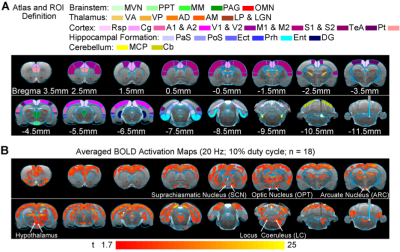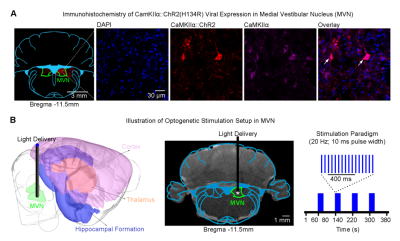Alex T. L. Leong1,2, Christopher Man1,2, Yong Gu3, and Ed X. Wu1,2
1Laboratory of Biomedical Imaging and Signal Processing, The University of Hong Kong, Hong Kong SAR, China, 2Department of Electrical and Electronic Engineering, The University of Hong Kong, Hong Kong SAR, China, 3Institute of Neuroscience, CAS Center for Excellence in Brain Science and Intelligence Technology, Chinese Academy of Sciences, Shanghai, China
1Laboratory of Biomedical Imaging and Signal Processing, The University of Hong Kong, Hong Kong SAR, China, 2Department of Electrical and Electronic Engineering, The University of Hong Kong, Hong Kong SAR, China, 3Institute of Neuroscience, CAS Center for Excellence in Brain Science and Intelligence Technology, Chinese Academy of Sciences, Shanghai, China
In this study, we deploy fMRI and optogenetic stimulation of vestibular excitatory neurons to examine the neural targets of the vestibular system in circadian circuits. We reveal that the vestibular system provides inputs to notable regions that drive and regulate circadian rhythms.

Figure 2. Brain-wide fMRI revealed activations at regions mediating circadian rhythms upon optogenetic stimulation of MVN excitatory neurons. (A) Illustration of Paxinos atlas-based ROI definitions in the vestibular and midbrain, thalamic, cortical, and hippocampal formation regions. (B) Averaged BOLD activation maps at 20Hz optogenetic stimulation (n=18; P<0.05; asterisk: stimulation site). Notably, these activations include SCN, OPT, ARC, hypothalamus and LC, regions that are known to drive and regulate the circadian clock.

Figure 1. Illustration of CaMKIIa::ChR2 viral expression in medial vestibular nucleus (MVN) excitatory neurons and optogenetic fMRI stimulation setup. (A) ChR2-mCherry expression in MVN. Lower-magnification (left) and higher-magnification (right). Overlay of images revealed colocalization of mCherry and CaMKII in the cell body of MVN neurons (indicated by white arrows). (B) Illustration of the stimulation site in ChR2 MVN excitatory neurons during optogenetic fMRI experiments (asterisk, stimulation site).